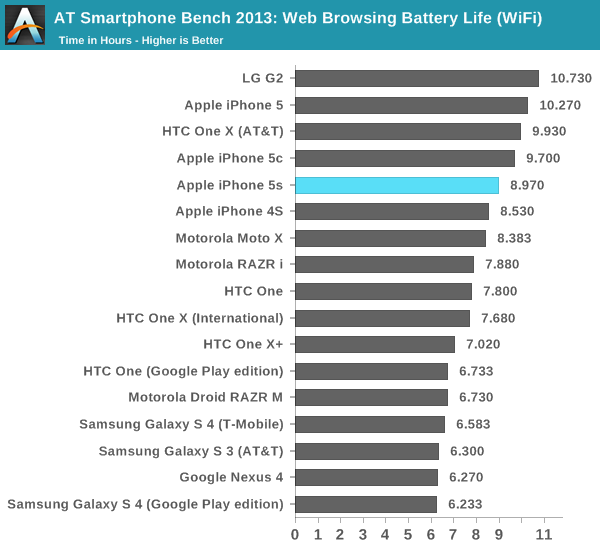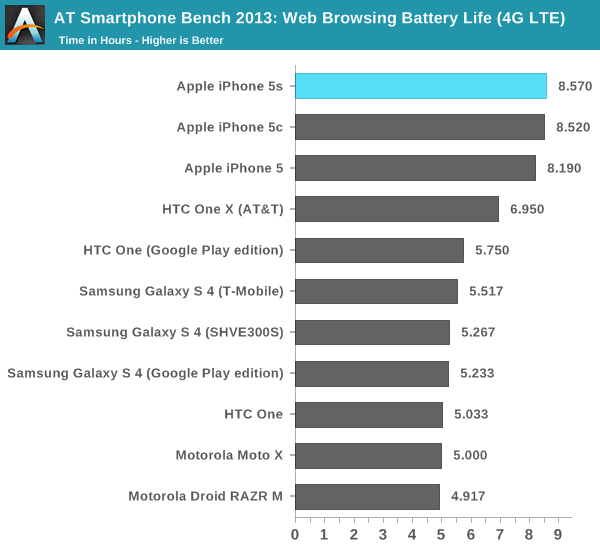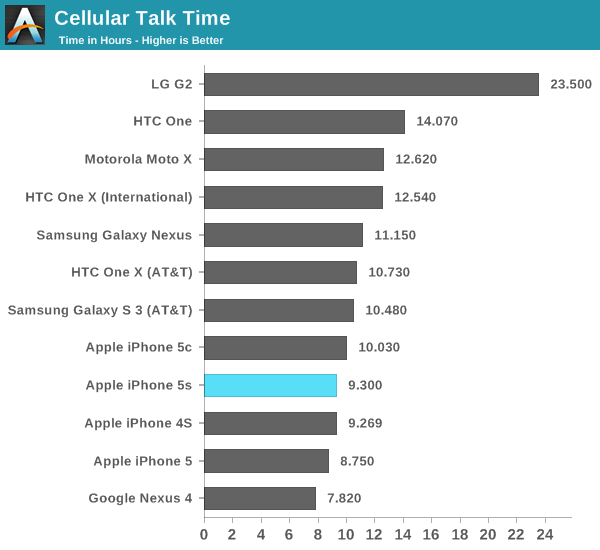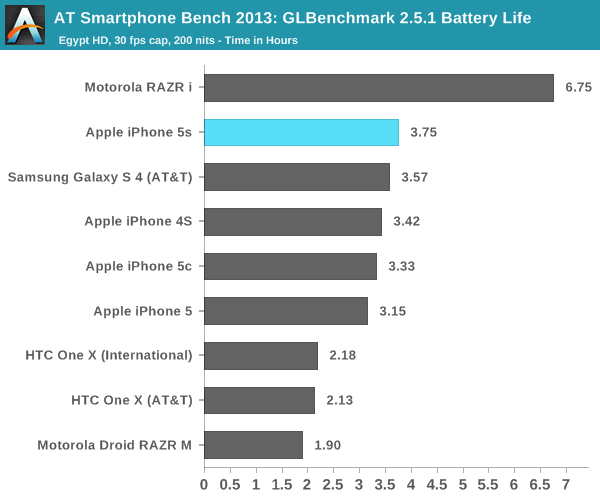The iPhone 5s Review
by Anand Lal Shimpi on September 17, 2013 9:01 PM EST- Posted in
- Smartphones
- Apple
- Mobile
- iPhone
- iPhone 5S
Battery Life
Brian did some excellent sleuthing and came across battery capacities for both the iPhone 5s and 5c in Apple’s FCC disclosures. The iPhone 5 had a 3.8V 5.45Wh battery, while the 5s boosts total capacity to 5.96Wh (an increase of 9.35%). The move to a 28nm process doesn’t come with all of the benefits of a full node shrink, and it’s likely not enough to completely offset the higher potential power draw of a much beefier SoC. Apple claims the same or better battery life on the 5s compared to the iPhone 5, in practice the answer is a bit more complicated.
Unlike previous designs, we’ve never had a half node shrink for an s-SKU. Both the iPhone 3GS and iPhone 4S stayed on the same process node as their predecessor and drove up performance. In the case of the 3GS, the performance gains outweighed their power cost, while in the case of the iPhone 4S we generally saw a regression.
The iPhone 5s improves power consumption by going to 28nm, but turns that savings into increased performance. The SoC also delivers a wider dynamic range of performance than we’ve ever seen from an Apple device. There’s as much CPU power here as the first 11-inch MacBook Air, and more GPU power than an iPad 4.
To find out the balance of power savings vs. additional performance I turned to our current battery life test suite, which we first introduced with the iPhone 5 review last year.
We'll start with our WiFi battery life test. As always, we regularly load web pages at a fixed interval until the battery dies (all displays are calibrated to 200 nits).

The iPhone 5s regresses a bit compared to the 5 in this test (~12% reduction despite the larger battery). We're loading web pages very aggressively here, likely keeping the A7 cores running at their most power hungry state. Even the 5c sees a bit of a regression compared to the 5, which makes me wonder if we're seeing some of the effects of an early iOS 7 release here.
The story on LTE is a bit different. Here we see a slight improvement in battery life compared to the iPhone 5, although the larger battery of the 5s doesn't seem to give it anything other than parity with the 5c:

Our cellular talk time test is almost entirely display and SoC independent, turning it mostly into a battery capacity test:

You can see the close grouping of the smaller iPhones at the bottom of the chart. There's a definite improvement in call time compared to the iPhone 5. We're finally up above iPhone 4S levels there.

Our Egypt HD based 3D battery life test gives us the first indication that Rogue, at least running fairly light code, can be more power efficient than the outgoing 5XT. Obviously the G6430 implemented here can run at fairly high performance levels, so I'm fully expecting peak power consumption to be worse but for more normal workloads there's no regression at all - a very good sign.










464 Comments
View All Comments
vampyren - Wednesday, October 2, 2013 - link
Great review, Sadly i feel so limited in iOS these days and also the screen size is just to small for my taste. I use Galaxy S4 and i'm really happy with it. my iPhone5 is still performing well as well but i use it less and less these days, hopefully Apple will make a larger screen phone next time. That might make me more willing to use iphone but not with 4inch.AEdouard - Sunday, October 6, 2013 - link
I'm sure they'll be offering a bigger option in 2014, for the regular iPhone or a new ''large'' iPhone model alongside the regular 4 inch option.Samwise - Wednesday, October 2, 2013 - link
Anandtech, please review the Droid MAXX.Duck <(' ) - Thursday, October 3, 2013 - link
Hello Anand, it seems that you actually are inflating the benchmark scores in case of apple for some unknown reasons. For ex- iPhone 5 in YouTube vids scores around 2300 while you show 2800. Check here https://www.youtube.com/watch?v=iATFnXociC4Duck <(' ) - Thursday, October 3, 2013 - link
You people are complete LIARS !!! Will never visit your site again. You have been bribed by apple but your website will suffer loss in reputation.varase - Thursday, October 3, 2013 - link
I wonder if any of these Android benchmarks are tainted by gamed benchmark code.mohammedkarou - Sunday, October 6, 2013 - link
i have the iPhone 5s 32gb black, while , gold color for sale and i have 30 units altogetherContact me for more details regarding the purchase of this and i will explain better iphone4sale32 and on email at : mohammedkarou@hotmail.com
Hrel - Monday, October 14, 2013 - link
I think in the 16:9 aspect ratio a 5" screen would probably be best. I'll never buy an apple product so I guess it doesn't really matter to me. But I think a thin bezel with a 5" 1080p screen is the way to go.Bossrulz - Tuesday, October 22, 2013 - link
Hi Anand. I am planning to buy my first iphone in the form of 5S.Is it worth to buy or to wait for iphone 6 ?
Is it good to buy in USA or in the country where I live in ?
Does iphone have internatiobnal warranty ?
beast from the east - Wednesday, October 30, 2013 - link
Intel only ever dominiated in sales, not processing power.I have installed Apple systems for 25 years, pre-Intel Macs, Apple's computers had twice the performance per clock cycle than the Intel equivalents. From the Motorola chips through to PowerPC.
That's one of the many reasons why graphics, video and the scientific community used Macs.
This chip is a beast, we all know it. With the best relationship in the mobile market with Developers that get paid for their work, a fantastic SDK, and Dev's talking about an hour to recompile to 64-bit. I think Apple will be alright.
Trying to pick holes is just 'Roid-Rage, plain and simple.